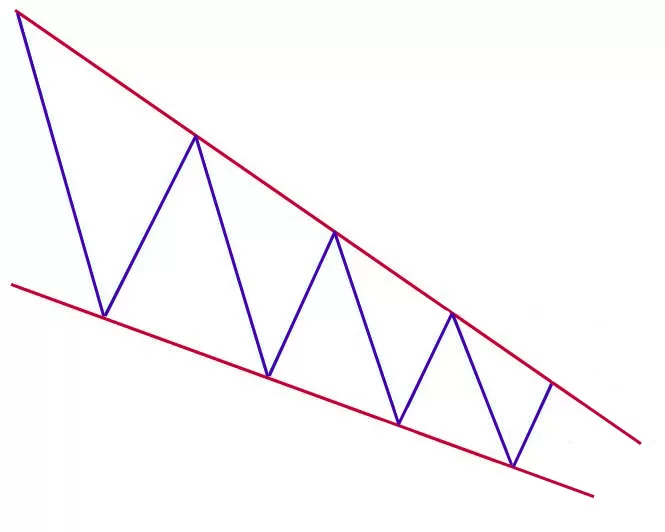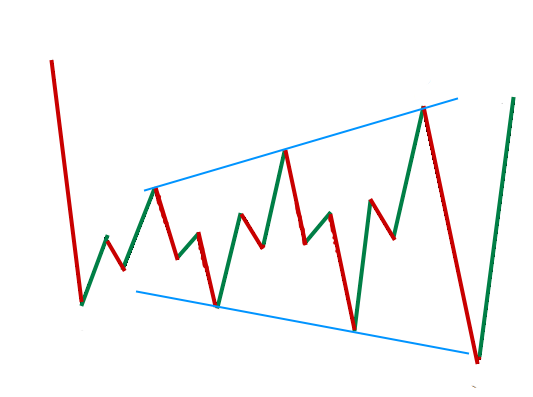The falling wedge pattern is a widely recognized chart pattern that indicates a potential bullish reversal in the market. It is formed by two descending trend lines, representing the highs and lows of an asset’s price movement. This pattern is often seen as a reliable signal for traders to anticipate a trend reversal and take advantage of potential buying opportunities.
What is the Falling Wedge Pattern
The falling wedge pattern is characterized by gradually narrowing the price range between the two trend lines. The trend line representing the highs has a lower slope than the trend line representing the lows. This indicates that the highs are decreasing faster than the lows, suggesting a weakening bearish pressure in the market.
To form a valid falling wedge pattern, there should be at least five reversals, with two for one trend line and three for the other. This pattern typically follows a climax trough, a sudden reversal of an uptrend, often accompanied by higher trading volume. The price within the falling wedge is expected to remain above the panic value, signifying a strong lower line of support.
Identifying a Falling Wedge Pattern
When analyzing a falling wedge pattern, traders should pay attention to several key characteristics. Firstly, the slope of the trend lines should be clearly descending, indicating a narrowing price range. Secondly, the volume during the pattern formation will likely decrease, suggesting a consolidation phase. Lastly, gaps before the breakout and high volume at the breakout point are considered positive indicators of the pattern’s performance.
Interpreting the Falling Wedge Pattern
The falling wedge pattern can be interpreted as a bullish reversal signal, signaling the end of a consolidation phase and the potential continuation of an overall uptrend. The pattern represents a period of calm before a potential storm, as buyers use the consolidation phase to regroup and attract new buying interest. Once the price breaks above the upper trend line, it often initiates a strong upward trend.
It’s important to note that the falling wedge pattern can also be seen as a continuation pattern in certain cases. However, the overall interpretation leans towards a bullish reversal signal. Traders should consider the context of the pattern formation and other technical indicators to make informed trading decisions.
Trading Strategies for the Falling Wedge Pattern
When trading the falling wedge pattern, traders can employ different strategies to maximize potential profits and manage risks. Here are some key considerations:
1. Entry Points and Stop Loss Levels
Traders can choose between two entry strategies for trading the falling wedge pattern. The first option is to enter a trade once the price closes above the upper trend line, confirming the breakout. This approach provides a safer entry but may result in a slightly higher price.
The second option is to wait for a potential pullback after the breakout, allowing the price action to retest the broken resistance level. This strategy may offer a better entry price, but there is a risk that the price may not pull back as expected.
Regarding stop loss levels, traders should place their orders within the wedge, near the upper trend line. Any close within the territory of the wedge invalidates the pattern and suggests a potential false breakout.
2. Take Profit Levels
To determine the take-profit level for a falling wedge pattern, traders can measure the distance between the two converging trend lines when the pattern is formed. This measurement can be added to the breakout point to identify the potential target for the upward price movement. Alternatively, traders can use other technical indicators or support and resistance levels to set their take profit levels.
3. Risk-Reward Ratio
Managing risk is crucial in any trading strategy. Traders should consider the risk-reward ratio when trading the falling wedge pattern. By assessing the potential profit against the risk taken, traders can determine if the trade is worth pursuing. It is generally advisable to aim for a risk-reward ratio of at least 1:2, where the potential profit is at least twice the potential loss.
4. Practice and Demo Trading
As with any trading strategy, it is essential to practice and gain experience before trading the falling wedge pattern with real capital. Opening a demo account allows traders to simulate trading scenarios and test their strategies in a risk-free environment. This practice helps traders become familiar with different trading approaches and enhances their ability to make well-informed decisions in live markets.
Conclusion
The falling wedge pattern is a powerful technical formation that gives traders valuable insights into potential trend reversals and buying opportunities. By understanding the characteristics of this pattern and employing effective trading strategies, traders can capitalize on the bullish signals it generates.
It is essential to combine the analysis of the falling wedge pattern with other technical indicators and market conditions to make informed trading decisions. With practice and experience, traders can harness the potential of the falling wedge pattern in their trading endeavors.
Do you have refined trading skills? Trade a Funding Pips account today and receive up to 90% profit.
- 8 Best Prop Firms USA: Real trader Reviews and Payouts - March 10, 2025
- Forex Trading in Uganda: Start With $10—An Incredible Opportunity on a Tight Budget! - February 24, 2025
- Master Forex Trading Algorithms: Your Path to Success in 2025 - February 17, 2025






